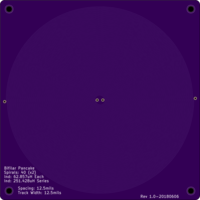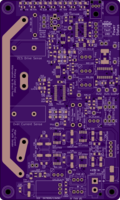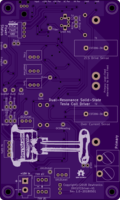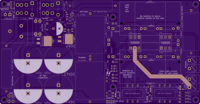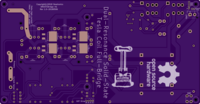Shared Projects by dewhisna
Shared Projects by dewhisna
Bifilar Pancake Coil V1
2 layer board of 4.48 x 4.48 inches (113.8 x 113.8 mm)
Uploaded:
June 06, 2018
Shared:
June 06, 2018
Total Price:
$100.35
Bifilar Pancake coil for experimentation. Each winding has 40 turns of a linearly-increasing radius (Archimedean Spiral). Inner-Spiral Spacing is 12.5mils (25mils center-to-center of alternating winding and 50mils center-to-center of same winding) and the Spiral Trace Width is 12.5mils. The ca…
Bifilar Pancake coil for experimentation. Each winding has 40 turns of a linearly-increasing radius (Archimedean Spiral). Inner-Spiral Spacing is 12.5mils (25mils center-to-center of alternating winding and 50mils center-to-center of same winding) and the Spiral Trace Width is 12.5mils. The calculated inductance of each winding is 62.857uH and the calculated combined inductance in series is 251.428uH (due to the mutual inductance effect).
Update: After receiving and measuring the board, I was happy to see that the measured values were extremely close to the above calculated/predicted inductance values:
Measured Inductance Values:
Inner Winding: 65.41uH
Outer Winding: 65.16uH
Windings in Series: 288.1uH
Measured Resistance Values (DC Impedance):
Each winding: 10.5Ω
Windings in series: 21.5Ω (also included wire connecting them in series)
Measured Winding to Winding capacitance: 383pF
Note: Measurements are subject to the error of my test gear, but seem somewhat reasonable and consistent with calculated/predicted values.
Show full description
Bifilar Pancake coil for experimentation. Each winding has 40 turns of a linearly-increasing radius (Archimedean Spiral). Inner-Spiral Spacing is 12.5mils (25mils center-to-center of alternating winding and 50mils center-to-center of same winding) and the Spiral Trace Width is 12.5mils. The ca…
Bifilar Pancake coil for experimentation. Each winding has 40 turns of a linearly-increasing radius (Archimedean Spiral). Inner-Spiral Spacing is 12.5mils (25mils center-to-center of alternating winding and 50mils center-to-center of same winding) and the Spiral Trace Width is 12.5mils. The calculated inductance of each winding is 62.857uH and the calculated combined inductance in series is 251.428uH (due to the mutual inductance effect).
Update: After receiving and measuring the board, I was happy to see that the measured values were extremely close to the above calculated/predicted inductance values:
Measured Inductance Values:
Inner Winding: 65.41uH
Outer Winding: 65.16uH
Windings in Series: 288.1uH
Measured Resistance Values (DC Impedance):
Each winding: 10.5Ω
Windings in series: 21.5Ω (also included wire connecting them in series)
Measured Winding to Winding capacitance: 383pF
Note: Measurements are subject to the error of my test gear, but seem somewhat reasonable and consistent with calculated/predicted values.
Show full description
-
Actions
- Order Board
- Download
- Permalink
- Embed link
Ordering shared project
Hey there! Before ordering, make sure you have all the info you need to complete and use this design. This usually means a component list, and sometimes additional information such as assembly notes, source code, or usage guides.Since this is a project designed by a community member, it may contain design errors that prevent it from working as intended. OSH Park cannot place any guarantees about the functionality or correctness of the design.
Dual-Resonance Solid-State Tesla Coil Driver V1
2 layer board of 3.01 x 5.01 inches (76.4 x 127.2 mm)
Uploaded:
May 30, 2018
Shared:
May 30, 2018
Total Price:
$75.20
NOTE: This board has been replaced by DRSSTC Driver V2.
Driver board for a Dual-Resonance Solid-State Musical Tesla Coil. This design features a zero-current-switching phase-lead circuit, an over-current detection/lockout circuit, an under-…
NOTE: This board has been replaced by DRSSTC Driver V2.
Driver board for a Dual-Resonance Solid-State Musical Tesla Coil. This design features a zero-current-switching phase-lead circuit, an over-current detection/lockout circuit, an under-voltage lockout circuit, and a PLL-based adjustable dead-time delay. Requires regulated 15VDC power supply. It’s designed to be used with the Dual-Resonance Solid-State Tesla Coil Full Bridge board.
Drive two of these with the FPGA-Based Dual-Resonance Solid-State Stereo Music Tesla Coil Interrupter.
The debut performance for this board was during Shock-or-Treat Halloween 2018, and can be viewed at: http://mediadrop.dewtronics.com/media/media/shock-or-treat-halloween-2018.
Note: This board is still in the prototyping/testing phase and hasn’t been fully qualified yet. Build at your own risk.
Errata: Oops, just realized I goofed the via hole size. They were supposed to be 25mil, but are 35mil instead. The vias are 46mil diameter, so it’s still within fabrication specs, but just barely. I hate cutting things that close to minimum tolerance specs.
Also, resistor R5 should be a 330-Ohm instead of 470-Ohm to allow the Blue LED to be a little brighter, as Blue LEDs require more current. And, the 1K-Ohm R9 should be at least a ½-Watt part and preferably 1-Watt, or you will risk burning it up from the high-voltage peaks of the current-transformer in the zero-current-switching circuit, which occurred during the first static-load test performed on this board. Unfortunately, finding such a large wattage part in a 0805 footprint will be difficult, if not impossible, meaning a large through-hole part will have to be graft in.
Show full description
NOTE: This board has been replaced by DRSSTC Driver V2.
Driver board for a Dual-Resonance Solid-State Musical Tesla Coil. This design features a zero-current-switching phase-lead circuit, an over-current detection/lockout circuit, an under-…
NOTE: This board has been replaced by DRSSTC Driver V2.
Driver board for a Dual-Resonance Solid-State Musical Tesla Coil. This design features a zero-current-switching phase-lead circuit, an over-current detection/lockout circuit, an under-voltage lockout circuit, and a PLL-based adjustable dead-time delay. Requires regulated 15VDC power supply. It’s designed to be used with the Dual-Resonance Solid-State Tesla Coil Full Bridge board.
Drive two of these with the FPGA-Based Dual-Resonance Solid-State Stereo Music Tesla Coil Interrupter.
The debut performance for this board was during Shock-or-Treat Halloween 2018, and can be viewed at: http://mediadrop.dewtronics.com/media/media/shock-or-treat-halloween-2018.
Note: This board is still in the prototyping/testing phase and hasn’t been fully qualified yet. Build at your own risk.
Errata: Oops, just realized I goofed the via hole size. They were supposed to be 25mil, but are 35mil instead. The vias are 46mil diameter, so it’s still within fabrication specs, but just barely. I hate cutting things that close to minimum tolerance specs.
Also, resistor R5 should be a 330-Ohm instead of 470-Ohm to allow the Blue LED to be a little brighter, as Blue LEDs require more current. And, the 1K-Ohm R9 should be at least a ½-Watt part and preferably 1-Watt, or you will risk burning it up from the high-voltage peaks of the current-transformer in the zero-current-switching circuit, which occurred during the first static-load test performed on this board. Unfortunately, finding such a large wattage part in a 0805 footprint will be difficult, if not impossible, meaning a large through-hole part will have to be graft in.
Show full description
-
Actions
- Order Board
- Download
- Permalink
- Embed link
Ordering shared project
Hey there! Before ordering, make sure you have all the info you need to complete and use this design. This usually means a component list, and sometimes additional information such as assembly notes, source code, or usage guides.Since this is a project designed by a community member, it may contain design errors that prevent it from working as intended. OSH Park cannot place any guarantees about the functionality or correctness of the design.
Dual-Resonance Solid-State Tesla Coil Full Bridge V1
2 layer board of 9.66 x 5.01 inches (245.3 x 127.2 mm)
Uploaded:
May 29, 2018
Shared:
May 30, 2018
Total Price:
$241.65
NOTE: This board has been replaced by DRSSTC Bus Supply V1 and DRSSTC Bridge V2 as a modular pair.
Full-Bridge power circuit for running a small desktop Musical Tesla Coil from 110/120 VAC. Thi…
NOTE: This board has been replaced by DRSSTC Bus Supply V1 and DRSSTC Bridge V2 as a modular pair.
Full-Bridge power circuit for running a small desktop Musical Tesla Coil from 110/120 VAC. This design features a Soft-Start power-up circuit and relay controlled power-off voltage bleeder circuit. Note: Soft-Start and power rectification circuits are NOT compatible with 220/240 VAC! Recommend using 2oz Copper.
This board is designed to be driven by the Dual-Resonance Solid-State Tesla Coil Driver board.
The debut performance for this board was during Shock-or-Treat Halloween 2018, and can be viewed at: http://mediadrop.dewtronics.com/media/media/shock-or-treat-halloween-2018.
Note: This board is still in the prototyping/testing phase and hasn’t been fully qualified yet. Build at your own risk.
ERRATA: Do NOT build this circuit as-is. The soft-start circuit has a design flaw that causes SCR (D29) to false trigger early and to “bounce”, which causes the Soft-Start Relay RL1 to chatter and fuse its contacts due to the high inrush current, ruining the relay. The high inrush current will then fry one or both mains input rectifier diodes D32 and/or D33, and then blow the fuse.
If building, do not install the following components: RL1, D29, D30, D31, R5, R6, R7, R8, R9, RV1, C2, and R14. In the place of R14, install a NTC Thermistor Inrush Current Limiter, such as Ametherm MS22-10008 (DigiKey: 570-1003-ND) – note that this can be installed between pads 41 and 44 of the RL1 footprint for closer pin spacing, but give it plenty of air space and ventilation, as it will get hot. You can also use a variac to slowly bring up power to the entire circuit – but you’ll need to start it at around 70 volts to keep the Bleeder Relay RL2 from chattering.
Also, resistor R10 needs to be a sufficiently high wattage part. It will have about a 155-160Volt drop at 3.3mA, which is 530mW. So, use at least a 3/4Watt resistor for R10 or risk it leaking its “magic smoke”.
Note that at circuit power-down, resistor R15 will get a little toasty. This is normal. However, your driving circuit should monitor the ‘fault’ pin (pin 3 of J1) and shutdown all AC input if the fault condition (i.e. Relay RL2 open) exists for more than a few seconds, as the 2.5W rating of R15 is only sufficient as a bleeder resistor for the system. A continuous load resistor of that value would have to be around 120Watts. If the 2.5W part was left in the circuit very long (longer than the required voltage bleed down period), it would either burn in two or catch fire.
Also, cut the copper-pour trace for the ground fill where it runs underneath the fuse holder. Failure to do this will cause a short between the 120VAC mains and ground under the 120VAC-input end of the fuse holder when the solder-mask gets breached beneath it. Apparently, I should have made the area under the fuse a keepout-area for that copper pour. It is, however, a self-correcting problem, because when it shorts, the trace, and select parts of the fuse holder, will vaporize. But it is a rather loud and startling bang, and you’ll probably have to reset the circuit breaker for your power feed.
Show full description
NOTE: This board has been replaced by DRSSTC Bus Supply V1 and DRSSTC Bridge V2 as a modular pair.
Full-Bridge power circuit for running a small desktop Musical Tesla Coil from 110/120 VAC. Thi…
NOTE: This board has been replaced by DRSSTC Bus Supply V1 and DRSSTC Bridge V2 as a modular pair.
Full-Bridge power circuit for running a small desktop Musical Tesla Coil from 110/120 VAC. This design features a Soft-Start power-up circuit and relay controlled power-off voltage bleeder circuit. Note: Soft-Start and power rectification circuits are NOT compatible with 220/240 VAC! Recommend using 2oz Copper.
This board is designed to be driven by the Dual-Resonance Solid-State Tesla Coil Driver board.
The debut performance for this board was during Shock-or-Treat Halloween 2018, and can be viewed at: http://mediadrop.dewtronics.com/media/media/shock-or-treat-halloween-2018.
Note: This board is still in the prototyping/testing phase and hasn’t been fully qualified yet. Build at your own risk.
ERRATA: Do NOT build this circuit as-is. The soft-start circuit has a design flaw that causes SCR (D29) to false trigger early and to “bounce”, which causes the Soft-Start Relay RL1 to chatter and fuse its contacts due to the high inrush current, ruining the relay. The high inrush current will then fry one or both mains input rectifier diodes D32 and/or D33, and then blow the fuse.
If building, do not install the following components: RL1, D29, D30, D31, R5, R6, R7, R8, R9, RV1, C2, and R14. In the place of R14, install a NTC Thermistor Inrush Current Limiter, such as Ametherm MS22-10008 (DigiKey: 570-1003-ND) – note that this can be installed between pads 41 and 44 of the RL1 footprint for closer pin spacing, but give it plenty of air space and ventilation, as it will get hot. You can also use a variac to slowly bring up power to the entire circuit – but you’ll need to start it at around 70 volts to keep the Bleeder Relay RL2 from chattering.
Also, resistor R10 needs to be a sufficiently high wattage part. It will have about a 155-160Volt drop at 3.3mA, which is 530mW. So, use at least a 3/4Watt resistor for R10 or risk it leaking its “magic smoke”.
Note that at circuit power-down, resistor R15 will get a little toasty. This is normal. However, your driving circuit should monitor the ‘fault’ pin (pin 3 of J1) and shutdown all AC input if the fault condition (i.e. Relay RL2 open) exists for more than a few seconds, as the 2.5W rating of R15 is only sufficient as a bleeder resistor for the system. A continuous load resistor of that value would have to be around 120Watts. If the 2.5W part was left in the circuit very long (longer than the required voltage bleed down period), it would either burn in two or catch fire.
Also, cut the copper-pour trace for the ground fill where it runs underneath the fuse holder. Failure to do this will cause a short between the 120VAC mains and ground under the 120VAC-input end of the fuse holder when the solder-mask gets breached beneath it. Apparently, I should have made the area under the fuse a keepout-area for that copper pour. It is, however, a self-correcting problem, because when it shorts, the trace, and select parts of the fuse holder, will vaporize. But it is a rather loud and startling bang, and you’ll probably have to reset the circuit breaker for your power feed.
Show full description
-
Actions
- Order Board
- Download
- Permalink
- Embed link
Ordering shared project
Hey there! Before ordering, make sure you have all the info you need to complete and use this design. This usually means a component list, and sometimes additional information such as assembly notes, source code, or usage guides.Since this is a project designed by a community member, it may contain design errors that prevent it from working as intended. OSH Park cannot place any guarantees about the functionality or correctness of the design.
Very Simple Musical Interrupter V1
2 layer board of 2.46 x 2.33 inches (62.4 x 59.2 mm)
Uploaded:
April 28, 2018
Shared:
April 28, 2018
Total Price:
$28.60
Very Simple Musical Interrupter for driving dual Tesla Coils in stereo from Direct Audio. This is a custom variation of the original Dual VSMI 2.0 by Grégory Gusberti and Fabrício Franzoli as found on Alex Yuan's website: [http://www.personal.psu.edu/ahy5028/coiling/Schematics/Dual_VSMI.jpg](htt…
Very Simple Musical Interrupter for driving dual Tesla Coils in stereo from Direct Audio. This is a custom variation of the original Dual VSMI 2.0 by Grégory Gusberti and Fabrício Franzoli as found on Alex Yuan’s website: http://www.personal.psu.edu/ahy5028/coiling/Schematics/Dual_VSMI.jpg. I built it to see how it compares with my other attempts at making a decent direct audio interrupter for Tesla Coils.
All ICs are TSSOP packages. All resistors and capacitors are 0805 footprint, with the exception of C6, C12, C13, C15, and C17, which are 1206. The LEDs are 1206 package. All thru-hole components (i.e. the connectors and potentiometers), plus the two LEDs, mount on the bottom side, which is designed to be the “top” in the final assembly.
To the original design, this version adds a headphone/speaker monitor output and fiber optic transmitters for driving a Tesla Coil control board. Reference designators have been kept in sync with the original schematic referenced above.
Errata: The 10K “Sensitivity” potentiometers, RV1 and RV3, operate backwards – turning them CCW increases sensitivity and turning them CW decreases sensitivity. Additionally, the Sensitivity potentiometers really do little to nothing at all, as the only time it will detect the incoming signal is if you crank the volume on your device to max and turn this circuit to maximum sensitivity. This seems to be a design flaw in the original circuit. So you might as well skip the Sensitivity controls and tie them directly to ground or do a fixed-resistor divider network like their other circuit variation at http://www.personal.psu.edu/ahy5028/coiling/Schematics/VSMI_REVB.jpg.
Also, the high-impedance DC-coupled pull-up on the inputs causes some phone/player type devices that use the bias/loading on their headphone jacks to detect connection/disconnection, to incorrectly think you have unplugged the cable from the jack. In other words, it can’t detect that this device is plugged in. My Android Samsung player device behaved that way.
Otherwise, it does function. The quality of the chopped audio, though, isn’t nearly as good as I had hoped. It’s comparable to several other attempts at a direct audio interrupter.
Show full description
Very Simple Musical Interrupter for driving dual Tesla Coils in stereo from Direct Audio. This is a custom variation of the original Dual VSMI 2.0 by Grégory Gusberti and Fabrício Franzoli as found on Alex Yuan's website: [http://www.personal.psu.edu/ahy5028/coiling/Schematics/Dual_VSMI.jpg](htt…
Very Simple Musical Interrupter for driving dual Tesla Coils in stereo from Direct Audio. This is a custom variation of the original Dual VSMI 2.0 by Grégory Gusberti and Fabrício Franzoli as found on Alex Yuan’s website: http://www.personal.psu.edu/ahy5028/coiling/Schematics/Dual_VSMI.jpg. I built it to see how it compares with my other attempts at making a decent direct audio interrupter for Tesla Coils.
All ICs are TSSOP packages. All resistors and capacitors are 0805 footprint, with the exception of C6, C12, C13, C15, and C17, which are 1206. The LEDs are 1206 package. All thru-hole components (i.e. the connectors and potentiometers), plus the two LEDs, mount on the bottom side, which is designed to be the “top” in the final assembly.
To the original design, this version adds a headphone/speaker monitor output and fiber optic transmitters for driving a Tesla Coil control board. Reference designators have been kept in sync with the original schematic referenced above.
Errata: The 10K “Sensitivity” potentiometers, RV1 and RV3, operate backwards – turning them CCW increases sensitivity and turning them CW decreases sensitivity. Additionally, the Sensitivity potentiometers really do little to nothing at all, as the only time it will detect the incoming signal is if you crank the volume on your device to max and turn this circuit to maximum sensitivity. This seems to be a design flaw in the original circuit. So you might as well skip the Sensitivity controls and tie them directly to ground or do a fixed-resistor divider network like their other circuit variation at http://www.personal.psu.edu/ahy5028/coiling/Schematics/VSMI_REVB.jpg.
Also, the high-impedance DC-coupled pull-up on the inputs causes some phone/player type devices that use the bias/loading on their headphone jacks to detect connection/disconnection, to incorrectly think you have unplugged the cable from the jack. In other words, it can’t detect that this device is plugged in. My Android Samsung player device behaved that way.
Otherwise, it does function. The quality of the chopped audio, though, isn’t nearly as good as I had hoped. It’s comparable to several other attempts at a direct audio interrupter.
Show full description
-
Actions
- Order Board
- Download
- Permalink
- Embed link
Ordering shared project
Hey there! Before ordering, make sure you have all the info you need to complete and use this design. This usually means a component list, and sometimes additional information such as assembly notes, source code, or usage guides.Since this is a project designed by a community member, it may contain design errors that prevent it from working as intended. OSH Park cannot place any guarantees about the functionality or correctness of the design.
FPGA-Based Dual-Resonance Solid-State Stereo Music Tesla Coil Interrupter V1
2 layer board of 4.91 x 3.31 inches (124.6 x 84.0 mm)
Uploaded:
April 09, 2018
Shared:
April 09, 2018
Total Price:
$81.05
FPGA-Based Solid-State Stereo Musical Tesla Coil Interrupter interface board. Uses the Numato Mimas Spartan 6 FPGA Module to generate 512-note polyphony (256 per channel) Tesla Coil interrupter signals to drive two Musical Tesl…
FPGA-Based Solid-State Stereo Musical Tesla Coil Interrupter interface board. Uses the Numato Mimas Spartan 6 FPGA Module to generate 512-note polyphony (256 per channel) Tesla Coil interrupter signals to drive two Musical Tesla Coils in stereo from MIDI and other audio sources at a 1.5625 MHz note-timer resolution.
It was originally designed to function with the Netduino Plus 2 host processor board, but will function with any Arduino R3 compatible host processor. It supports both 3.3v and 5v host interfaces with on-board level translators. Power can be supplied with 7.4v LiPo battery pack and monitored with on-board low-voltage detector circuit. This board includes a 4-button keypad connector and an I2C Interface circuit for connecting a 4x20 or similar character-based LCD screen (or other +5V I2C devices).
I built this to run two of the original v.1 old-style oneTesla Musical Tesla Coils running in stereo. I wanted something more hi-fidelity than their simplistic 2-note interrupter. I wanted an interrupter that you could actually play an entire orchestral piece through with complete fidelity, including pitch-bends and power level shift nuances. The only way to get enough capture-compare timers was to use an FPGA. I made the VHDL code for the FPGA available on OpenCores as Timer Output Compare Driver. Note: To access the source tree without needing an OpenCores account, click the “Browse” link next to the “SVN” label in the top left corner. The source files are in “timerocd/trunk/src/”, which can be built under the free version of Xilinx ISE. The prebuilt binary file is at “timerocd/trunk/xilinx/TimerOCD/TimerOCD.bin”, which can be loaded directly into the Numato Mimas module using the Python programming scripts on the Numato website.
Here’s a demo of the first prototype of this interrupter back when it was still running at 16-note polyphony on a single Tesla Coil: Amazing Grace on the Musical Tesla Coil. I don’t yet have a video of dual-coils on the new FPGA interrupter as I’m in the process of redesigning the primary windings to improve tunability (it isn’t perfectly tuned in this demo video – the arc should be even bigger!) and to try to alleviate some arc-over problems I’ve been experiencing (oh the joys of working with high voltage).
Final code for the host processor is still being developed.
ERRATA: The LiPo low-battery detection circuit on this board, while it works well in general, has a flaw in the output to the MCU. Due to the transistor connections between the base of Q7 and the gate of Q9, the signal to the MCU will not change when the low-battery LED is activated. One possible fix is to cut the trace going to the gate of Q9 and connect it to the collector of Q7 instead of the base of Q7. This will invert the logic level for the low-battery signal in the process, but it should let the signal actually function.
NOTE: This board has been replaced by the improved FPGA DRSSTC Interrupter V2 Board design.
Show full description
FPGA-Based Solid-State Stereo Musical Tesla Coil Interrupter interface board. Uses the Numato Mimas Spartan 6 FPGA Module to generate 512-note polyphony (256 per channel) Tesla Coil interrupter signals to drive two Musical Tesl…
FPGA-Based Solid-State Stereo Musical Tesla Coil Interrupter interface board. Uses the Numato Mimas Spartan 6 FPGA Module to generate 512-note polyphony (256 per channel) Tesla Coil interrupter signals to drive two Musical Tesla Coils in stereo from MIDI and other audio sources at a 1.5625 MHz note-timer resolution.
It was originally designed to function with the Netduino Plus 2 host processor board, but will function with any Arduino R3 compatible host processor. It supports both 3.3v and 5v host interfaces with on-board level translators. Power can be supplied with 7.4v LiPo battery pack and monitored with on-board low-voltage detector circuit. This board includes a 4-button keypad connector and an I2C Interface circuit for connecting a 4x20 or similar character-based LCD screen (or other +5V I2C devices).
I built this to run two of the original v.1 old-style oneTesla Musical Tesla Coils running in stereo. I wanted something more hi-fidelity than their simplistic 2-note interrupter. I wanted an interrupter that you could actually play an entire orchestral piece through with complete fidelity, including pitch-bends and power level shift nuances. The only way to get enough capture-compare timers was to use an FPGA. I made the VHDL code for the FPGA available on OpenCores as Timer Output Compare Driver. Note: To access the source tree without needing an OpenCores account, click the “Browse” link next to the “SVN” label in the top left corner. The source files are in “timerocd/trunk/src/”, which can be built under the free version of Xilinx ISE. The prebuilt binary file is at “timerocd/trunk/xilinx/TimerOCD/TimerOCD.bin”, which can be loaded directly into the Numato Mimas module using the Python programming scripts on the Numato website.
Here’s a demo of the first prototype of this interrupter back when it was still running at 16-note polyphony on a single Tesla Coil: Amazing Grace on the Musical Tesla Coil. I don’t yet have a video of dual-coils on the new FPGA interrupter as I’m in the process of redesigning the primary windings to improve tunability (it isn’t perfectly tuned in this demo video – the arc should be even bigger!) and to try to alleviate some arc-over problems I’ve been experiencing (oh the joys of working with high voltage).
Final code for the host processor is still being developed.
ERRATA: The LiPo low-battery detection circuit on this board, while it works well in general, has a flaw in the output to the MCU. Due to the transistor connections between the base of Q7 and the gate of Q9, the signal to the MCU will not change when the low-battery LED is activated. One possible fix is to cut the trace going to the gate of Q9 and connect it to the collector of Q7 instead of the base of Q7. This will invert the logic level for the low-battery signal in the process, but it should let the signal actually function.
NOTE: This board has been replaced by the improved FPGA DRSSTC Interrupter V2 Board design.
Show full description
-
Actions
- Order Board
- Download
- Permalink
- Embed link
Ordering shared project
Hey there! Before ordering, make sure you have all the info you need to complete and use this design. This usually means a component list, and sometimes additional information such as assembly notes, source code, or usage guides.Since this is a project designed by a community member, it may contain design errors that prevent it from working as intended. OSH Park cannot place any guarantees about the functionality or correctness of the design.
- SERVICES
- Upload Your File
- Prototypes
- HELP
- Support
- If you can't find what you're looking for, please contact us at [email protected]
- CONNECT
- Shared Projects
- Log in / Sign up
